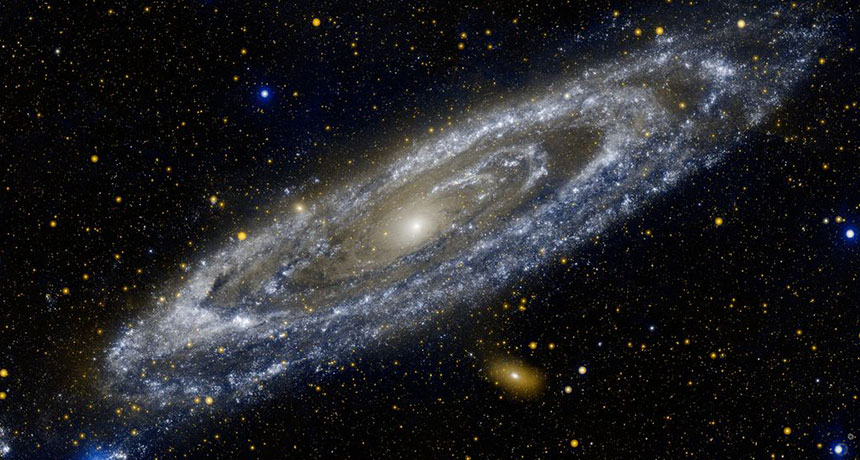In 20th century, astronomers opened their minds to gazillions of galaxies

WASHINGTON — Before astronomers could discover the expansion of the universe, they had to expand their minds.
When the 20th century began, astronomers not only didn’t know the universe was expanding, they didn’t even care.
“Astronomers in the late 19th century and the very start of the 20th century were very little interested in what we would call the broader universe or its history,” says historian of science Robert Smith of the University of Alberta in Canada.
Some astronomers were interested in the structure of the Milky Way galaxy, the vast collection of stars in which the sun, Earth and known planets reside. “But astronomers played next to no part in the debates at the end of the 19th century about the wider nature of the cosmos,” Smith said in a talk January 28 at a meeting of the American Physical Society. In fact, many scientists believed there was no wider cosmos. Majority opinion held that the Milky Way galaxy, more or less, constituted the entire universe.
“As far as almost all astronomers were concerned, the universe beyond our own limited system of stars was the realm of metaphysics, and working astronomers did not engage in metaphysics,” Smith said.
Astronomers left others to do the wondering.
“The infinite universe beyond our stellar system was territory that professional astronomers really were very happy to leave to mathematicians, physicists, philosophers and some popularizers,” Smith said.
Even among those groups, pre-20th century consensus limited the universe to the Milky Way and its immediate environs. Clues to the contrary were mostly dismissed. Most prominent among those clues was the existence of “spiral nebulae,” fuzzy patches of light clearly distinct from the pointlike stars. Photos of the spiral-shaped blobs suggested that they were solar systems in the making within or around the Milky Way; many people believed the galaxy was home to countless populated planets. Very few people believed that the nebulae were distant replicas of the Milky Way, galaxies in their own right.
In a book published in 1890, for instance, astronomer and respected science popularizer Agnes Clerke wrote that “no competent thinker” believed that nebulae could be galaxies. She retained that view in a later edition published in 1905, Smith said.
But after around 1905, he said, the modern conception of the cosmos began to emerge. Philanthropic contributions in support of new, large telescopes, particularly in the American West, led to observations that slowly transformed the restricted view of a one-galaxy universe into the current commodious cosmos, with billions and billions (technically, gazillions) of galaxies.
At Lick Observatory in California, for instance, James Keeler undertook the task of counting the spiral nebulae. At the time, astronomers knew of a few dozen. Keeler found hundreds of thousands.
“So the spiral nebulae are elevated in importance by Keeler,” Smith said.
By 1912, Vesto Slipher, at Lowell Observatory in Arizona, began reporting measurements of the light emanating from the nebulae, determining how far colors were shifted to the red end of the spectrum, a way to measure how fast the nebulae were flying away from the Earth.
“He would actually start arguing that the spiral nebulae were distant galaxies,” Smith said.
By the 1920s, more and more astronomers took the idea of distant galaxies seriously. Finally Edwin Hubble, at the Mount Wilson Observatory in Southern California, provided the deathblow to the one-galaxy universe. In 1923, his observations of the Andromeda nebula turned up a couple of Cepheid variable stars. Because Cepheids varied in brightness on a regular schedule that depended on their intrinsic brightness, they provided surefire clues to Andromeda’s distance from Earth. Andromeda resided 900,000 light-years away, vastly farther than even the most exaggerated estimates of the Milky Way’s diameter.
Hubble’s use of Cepheids depended on the earlier pioneering work of Henrietta Swan Leavitt at the Harvard observatory. “Her discovery of the period-luminosity relationship in Cepheid variable stars is absolutely fundamental in transforming people’s ideas about first, our own galactic system and second, providing the means to demonstrate that galaxies do in fact exist,” Smith said.
By the end of the 1920s Hubble, combining his distance measurements with velocity measurement made by astronomer Milton Humason, had demonstrated that the farther a nebula was from Earth, the faster it appeared to fly away. That relationship formed the observational basis for the expanding universe. Hubble suggested as much in 1929. Others also realized that the new view of the cosmos implied an expanding universe; one, Georges Lemaître, proposed something very much like today’s Big Bang theory of the universe’s origin.
It took a while, though, for the idea of the universe as the expanding aftermath of a big explosion to open everybody’s mind. In 1935, for instance, the astronomer J.S. Plaskett called Lemaître’s ideas “speculation run wild without a shred of evidence.” Even Hubble was not entirely sure of his own discovery. In 1938, Smith pointed out, Hubble assessed the evidence as consistent with a static universe, while acknowledging that expansion could not be ruled out.
Today’s claims that other big bangs may have happened many times, creating a multitude of cosmic spacetime bubbles known as the multiverse, face similar objections. It’s true that the evidence for a multiverse is not conclusive, just as evidence in the 19th century was not conclusive that spiral nebulae were distant galaxies or “island universes” of their own. But given the historical precedent, it would be silly to say that “no competent thinker” would believe in the possibility of multiple universes today.